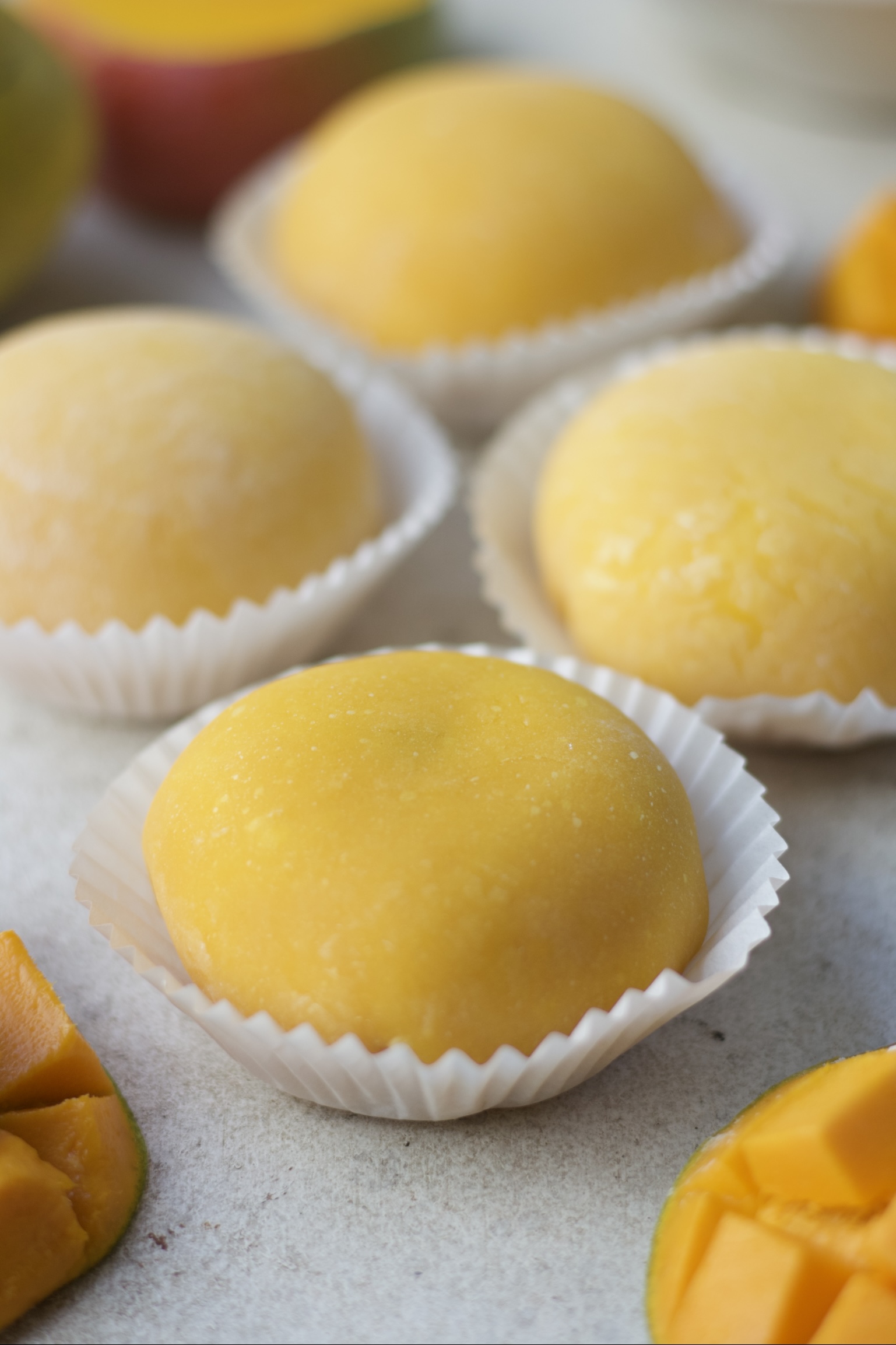There’s something about mangoes that just feels like summer in every bite—and when you wrap that juicy goodness inside soft, chewy mochi with a cloud of whipped cream, it’s pure magic. I still remember the first time I tried mochi; it was at a tiny restaurant, and I was completely fascinated by the texture—soft, stretchy and unlike anything I’d had before. Ever since, I’ve been obsessed with recreating it at home and this mango version is hands-down one of my favourites.
It’s surprisingly simple, requires no fancy tools or ingredients and comes together quickly in the microwave (yes, you read that right!). The result is a playful, pillowy treat that’s light, refreshing and perfect for impressing guests—or just treating yourself. If you’re new to mochi or slightly intimidated by the idea of working with sticky dough, don’t worry—I’ve got you. This recipe is beginner-friendly, foolproof and so much fun to make. So, grab your ripe mangoes and let’s get rolling (literally!).
WHAT YOU’LL LOVE ABOUT THIS RECIPE
- No-oven
- Quick and simple
- Minimal ingredients
- Eggless
- No fancy tools required

INGREDIENTS USED IN MANGO MOCHI
Rice flour
Glutinous rice flour is what gives mochi its signature chewy, stretch and elastic texture. When cooked, it forms a soft, pliable dough that can be shaped and filled easily—something no regular flour can replicate. Unlike regular rice flour or all-purpose flour, glutinous rice flour doesn’t just cook—it gels. That’s what creates the soft, sticky and slightly bouncy consistency mochi is loved for. It has a very mild, neutral taste, which allows the flavor of mango, sugar and cream to shine through while still giving the dessert body and substance.
Mangoes
Mango puree adds its own sweetness, allowing you to use less refined sugar while still getting a dessert that tastes indulgent and satisfying. Mango puree adds moisture to the dough, helping it become soft, tender and slightly sticky—the perfect texture for mochi. It blends beautifully with the glutinous rice flour to create a pliable, elastic dough. When used in chunks inside the mochi, mango offers a juicy, fresh bite that contrasts with the soft chewiness of the dough and the creaminess of the whipped filling. It’s like a mini explosion of flavor in the center.
Sugar
The most obvious role—sugar balances the tanginess of the mango and enhances the overall flavor of the mochi dough. Since mochi is usually paired with mildly sweet fillings like whipped cream or fruit, the dough itself needs a subtle sweetness to complement those flavors. Sugar slightly softens the mochi dough as it cooks, giving it a smoother, more elastic texture. It helps prevent the dough from becoming too rubbery or stiff once cooled. When combined with mango puree and cooked, sugar deepens the golden color and gently amplifies the natural fruity aroma of the mango.
Water
Glutinous rice flour needs a certain amount of liquid to hydrate properly. The mango puree adds moisture, but water ensures the dough isn’t too thick or dry. It helps loosen the mixture just enough to become smooth and spreadable. Water contributes to gentle steam during microwaving, which helps cook the mochi dough more evenly and prevents it from drying out or forming hard patches.
Cornflour
Glutinous rice dough is extremely sticky once cooked. Cornflour acts as a barrier between the dough and any surface it touches—your counter, rolling pin, hands or ramekin—making it manageable to roll and shape. A light dusting prevents the outside of the mochi from sticking to itself or becoming messy during folding and sealing.
EQUIPMENT USED FOR MAKING MANGO MOCHI
A correct proportion of all the ingredients will guarantee the best taste, so you will need measuring spoons and measuring cups to measure quantities of all the ingredients.
This is a very simple and quick recipe. It only requires a bowl and a microwave to bring this recipe together.
TIPS TO MAKE MANGO MOCHI
- Use glutinous rice flour, not regular rice flour. Look for sweet rice flour on the packaging. Regular rice flour won’t yield the soft, stretchy texture mochi is known for.
- After microwaving, the dough should look smooth, sticky and slightly glossy. If it still looks floury or raw, microwave it for another 30 seconds.
- The thinner the dough, the more delicate the mochi—but make sure it’s strong enough to hold the filling without tearing.
- Dust generously with cornflour: This prevents the dough from sticking to your surface, rolling pin and fingers. Keep a small bowl of cornflour handy while shaping.
- Mochi tastes best the same day. You can refrigerate them for a short while, but avoid storing too long, as the dough can harden in the fridge.
- Tap off any excess cornflour before serving for a cleaner bite.

OTHER RELATED RECIPES FROM THE BLOG
- 1 cup glutinous rice flour
- ½ cup mango puree
- 2 tbsp water
- 2 tbsp sugar
- Cornflour, for dusting
- FOR THE FILLING
- Whipped cream
- Mango cubes
- Take a microwave safe bowl and add the rice flour, mango puree, water and sugar to it. Give it a mix using a fork or chopsticks.
- Cover the bowl with a plate and microwave for 2.5 minutes – stirring after every one minute. The mixture should look thick, combined and a bit sticky.
- Let the mixture come to room temperature. Refrigerate it then, for 10-15 minutes.
- Dust some cornflour on a clean surface and place the cooled dough on it. Roll out the mixture into a smooth dough and divide it equally into 4-5 portions
- Roll out each portion into a circle as thin as possible.
- Take a small bowl or ramekin and place the rolled-out dough over it. Make sure the dough is larger in circumference than the ramekin and forms a cavity in centre.
- Pipe some whipped cream in this cavity and place a large chunk of mango in the centre.
- Add some more whipped cream to cover the mango and finally close the mochi dough into a small round ball.
- Cut off the excess dough and seal the edges properly.
If you like my easy Mango Mochi recipe and happen to make them in your kitchen, do tag me on Instagram and share pictures with me using #Bakewithshivesh. Happy Baking!

 Hello. I'm Shivesh Bhatia, a food blogger and food stylist from Delhi, India. Welcome to Bake With Shivesh, where I'll help you create magic in your kitchens with my simple recipes.
Hello. I'm Shivesh Bhatia, a food blogger and food stylist from Delhi, India. Welcome to Bake With Shivesh, where I'll help you create magic in your kitchens with my simple recipes.
Leave a Reply